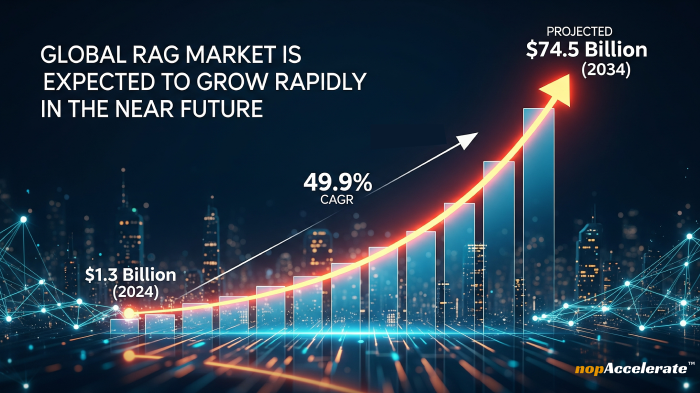Enjoyed this post?
Be sure to subscribe to the nopAccelerate newsletter and get regular updates about awesome posts just like this one and more!
If you’ve ever implemented an AI chatbot or search tool on your eCommerce store, you’ve probably had this moment:
A customer asks something totally reasonable, “Is this shoe waterproof?” or “When will the large size be back in stock?” and the AI either gives a generic answer, a wrong one, or worse: it makes something up.
Now imagine that happening hundreds of times a day across thousands of users. That’s not just poor UX: it’s lost trust, higher bounce rates, more support tickets, and ultimately, lost sales.
This problem isn’t due to lack of effort or budget. The truth is, most AI in eCommerce today runs on a flawed assumption: that a model trained once can handle a business that changes by the hour.
The typical Large Language Model (LLM) can’t see what’s going on in your ecommerce store. It doesn’t know what’s in stock, what’s trending, what just got returned, or what was asked last week.
And that’s where most AI projects hit a wall.
If your eCommerce store had a super-smart team member who could read every support ticket, product feed, catalog update, and customer review and answer questions based on that exact context, wouldn’t that change the game?
This is what Retrieval-Augmented Generation (RAG) brings to the table for e-commerce intelligence.
Unlike traditional LLMs that generate answers from frozen training data, RAG systems look things up in real time, just like a smart human would, before they respond.
It’s the difference between guessing and knowing.

RAG isn’t just another industry buzzword; it’s a proven technology delivering quantifiable results for e-commerce businesses. These aren’t theoretical experiments but real-world applications driving significant improvements in customer experience, operational efficiency, and ultimately, revenue.
These aren’t experiments, they’re growing edge strategies that help eCommerce players compete in a landscape where UX, accuracy, and immediacy directly influence revenue growth.
In simple language: RAG lets AI consult your store’s live data before answering.
Technically speaking, RAG breaks down into two interconnected layers:
You can update the knowledge base anytime, no retraining required. Add a new product, change pricing, publish a blog post, your AI will reflect it immediately.
This also means you can run AI across functions without worrying about outdated knowledge or inconsistent tone.
Here’s Key Applications of RAG in eCommerce, where RAG isn’t just useful, it’s transformational:
1. Search that Actually Understands What Users Want
Instead of keyword-based search that misses nuances, RAG-powered search understands intent:
2. Product Q&A That Doesn’t Guess
Automated responses can now reflect:
3. Chatbots with Context and Memory
A customer who chatted yesterday doesn’t have to repeat everything. Your AI knows the history, the product they viewed, the coupon they used and what didn’t work last time.
4. Support That’s Actually Helpful (Internally Too)
Customer agents and internal teams can ask:
The answers come from the store’s documentation, not some generic AI guess. This significantly reduces training time, improves agent efficiency, and leads to faster, more accurate resolutions for complex customer inquiries.
In eCommerce, speed, accuracy, and relevance make or break the customer experience. Retrieval-Augmented Generation (RAG) helps your store deliver all three, without needing constant manual updates or retraining.
Here’s how RAG adds value:
1. Smarter Search That Understands Product Context
Use Case: A customer types “waterproof running shoes for rainy season” into your store search.
With RAG: The AI pulls results not just by keyword, but by understanding your product descriptions, tags, and even reviews, surfacing items that truly match the intent, like “waterproof trainers” with high grip.
2. Real-Time Answers That Don’t Break During Campaigns
Use Case: You just launched a seasonal discount on select items. Your catalog updates daily, and customers are asking about updated prices and stock.
With RAG: The AI assistant pulls live pricing and inventory directly from your backend. No delays, no outdated info, so customers always get current, accurate responses.
3. Faster Support Without Extra Headcount
Use Case: Customers frequently ask about return eligibility, delivery time to their pincode, or warranty claims.
With RAG: The system responds using your actual return policy, logistics partner data, and product metadata. This reduces pressure on your support team while improving resolution speed.
4. Boost Conversions by Making Product Discovery Easy
Use Case: A shopper is browsing phone accessories but isn’t sure what fits their model.
With RAG: It cross-references product compatibility from your catalog, past queries, and product manuals. This offers accurate matches, reduces uncertainty, and increases likelihood of purchase.
5. Personalized Experiences Without Complicated Systems
Use Case: A repeat customer is back to buy again but wants something similar to what they purchased two months ago.
With RAG: The assistant recalls their past orders and suggests complementary or upgraded products, creating a personalized feel without needing a custom-built recommendation engine.
RAG flips the script on what’s possible with eCommerce AI.
It brings credibility to customer support. Support for complex eCommerce search queries. Relevance to automation. And speed to internal operations.
If your AI can’t answer questions grounded in what’s true right now about your store, then it’s time to rethink the foundation.
This blog isn’t just a trend piece. It’s a clear indicator of what high-performing eCommerce teams are already implementing.
Looking to Explore AI That Fits Your Ecommerce Store?
If you want using AI to drive revenue, reduce support load, or unlock smarter digital experiences, RAG is the playbook you can’t afford to ignore.
Leave A Comment